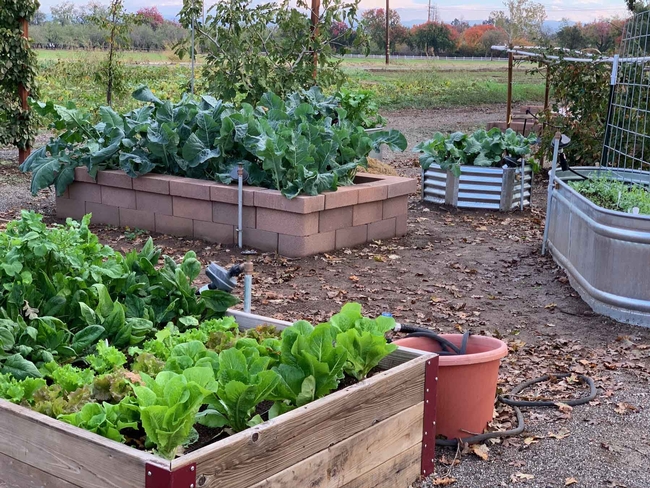Cool season plants like a warm start, so it’s not too early to begin adding some of them to the vegetable garden now. In this way you can extend the harvest of both warm season crops and cool season veggies.

In mid to late August, many warm season vegetable seeds will still have sufficient growing days to reach maturity. To figure out which vegetables can be planted now, look at the “days to maturity” on the back of the seed packet and count back from your region’s first frost date. Chico has a 10 percent risk of frost by October 29, and a 50 percent risk of frost by November 14. This gives the gardener at least 60 to 75 days before frost, which is enough time to grow a new batch of cucumbers, a second round of summer squash, and some varieties of lettuce and Asian greens.
Many fall crops survive a bit of chill. The date to plant out frost-tolerant transplants like kale, chard, broccoli, Brussels sprouts, and cauliflower is somewhat flexible. Broccoli, Brussels sprouts, and cauliflower are best started indoors or purchased as transplants.
But what to do about all the plants already growing in the beds? This is where the magic begins. Previously it was believed by many that plants compete with one another for nutrients and water. The planting bed had to be denuded of the early crop and maybe even left fallow for a time before replanting in that space. Newer research shows that plants grow better when a variety of other plants grow nearby. Dr. Christina Jones, a soil ecologist from Australia who speaks at regenerative agriculture forums throughout the world says, “Every plant exudes its own unique blend of sugars, enzymes, phenols, amino acids, nucleic acids, auxins, gibberellins and other biological compounds….The greater the diversity of plants, the greater the diversity of microbes and the more robust the soil ecosystem.” These various soil microbes bring nutrients to the plant in exchange for sugars discharged by the roots. The wider array of available nutrients from a diverse group of plants increases an individual plant’s ability to fight off diseases and pests, and increases the nutrient density of the plant. Basically, the plant grows better and is ultimately more nutritious when consumed. This diversity can be achieved by employing a combination of succession planting and “No Till” gardening techniques.
There are several approaches to succession planting.
- A crop can be seeded in the place where another plant was harvested.
- The next crop can be planted among the existing crop (intercropping). This has advantages in August since the foliage from older plants can offer sun protection to tender seedlings.
- Several compatible plants can be planted together (companion planting).
- The same crop can be seeded at different time intervals for continuous, smaller harvests (successive plantings).

So there are a variety of ways in which new plantings can be mixed into existing beds, but what is the best way to do this? The old image of a row of chard separated from a row of broccoli by a clean path of dirt is giving way to a more heterogeneous look. Farmer pioneers and soil scientists like David Montgomery, Anne Bikle, Dr. Christine Jones, Dr. David Johnson, and Gabe Brown urge farmers and gardeners to get rid of the shovel or plow, mulch like crazy, plant multiple species, leave roots in the soil, and get some cows. The cows may not be feasible in your yard, but incorporating the other principles can enhance the health of your garden and bring more nutrients to your food.
Rather than pull out existing veggies when they are dying off, cut them down at ground level. Immediately add some compost. Poke a hole the depth recommended for the seed you are planting. Drop seed into the hole. Pull the soil back over the seed and keep watered. Cover lightly with straw, grass clippings, or other mulch. Wait until the new plants are developing before adding a thicker coating of mulch.

To understand the advantages of No Till planting, imagine the roots of your existing plants creating a series of subterranean paths. These are channels which allow water to penetrate more deeply into the soil. They are the highways through which fungi, bacteria, and a world of other microbes travel. The casing of a root is covered with this life. In a vital, populated microbiome, it will take less time for roots of a new seedling to tap into this abundance than it would if it were being planted into a stripped environment. Digging and turning the soil also disrupts this preexisting helpful network.
Succession planting and starting cool season vegetables early will extend the harvest, but remember that it is hot and new plants dry out quickly. Water more frequently until your fall garden is established.
Source: UC Master Gardeners of Butte County, Published on: August 18, 2023
A global media for the latest news, entertainment, music fashion, and more.




